River systems can be developed and managed for fisheries at several levels. Firstly, at the basin level priorities must be set among a number of competing uses, of which fisheries is but one. Secondly, at the level of the fishery direct management techniques aim to control the types and amounts of fish being caught. Lastly, fisheries may be developed indirectly by inducing social changes or by the development of new types of fisheries. The actual techniques chosen for management depend on a clear formulation of the objectives of the fishery and of the larger socio-economic framework within which the fishery exists. Thus, in river basins where priorities have been given to urban or industrial development, the options open for the management of the fishery are restricted to those attainable within the productivity and community structure surviving in the modified aquatic ecosystems that result. The effects of such development external to the fishery can to a certain degree be mitigated by careful and early planning resulting in laws setting out minimum flow requirements for rivers or maximum permissible levels for discharge of toxic substances. At the level of the fishery itself a number of decisions have to be taken. The fish community may be called upon to fulfil a number of functions, such as the provision of food, recreational angling or the less definable appeal of just being present in the waters to name but a few. The fishery may be required to provide food for rural and urban communities as well as employment for fishermen. It may be based on a few large or especially favoured species or it may have to supply the maximum amount of fish protein irrespective of quality. Many of these objectives and others not mentioned here may conflict one with the other. For example, in most industrialized countries the fish stock has been exploited in the past by commercial fisheries, but these have been largely supplanted by sporting interests for economic and social reasons.
One of the most fundamental choices facing the fishery manager is whether to develop the fishery for a limited number of species only or to allow the fishery to expand over the whole range of species within the community. The first alternative requires strict and often costly controls of the fishery, while the second “laissez-faire” policy, may lead to the eventual degradation of the fish stock to the point that although more fish may be produced, its quality is unacceptable.
Policy decisions on the objectives of the fishery may be implemented in two main ways. Firstly, there is scientific management which involves initial research, which leads to an understanding of the system upon which management decisions can be based. This type of management is reliable, but is costly and time-consuming and often depends on a backlog of research experience over several decades. Because these conditions are seldom met in tropical and sub-tropical countries, an alternative approach has to be found for them. This second case, experimental management, involves the formulation of hypothesis about the fishery based on whatever information can be readily obtained. The management strategy is based on this hypothesis and its effects evaluated over a period of time, after which both hypothesis and strategy may be modified to better fit prevailing circumstances. This type of management is very common in traditional fisheries and is increasingly accepted as a legitimate approach where human and financial resources are not sufficient for scientific management. Obviously such empirical methods have to be closely controlled and require adequate monitoring for their evaluation.
The wide range of methods for the control of the fishery are illustrated in Fig. 15. Most of these depend on either legislative controls or economic controls to be effective but also presuppose the existence of technical knowledge needed for correct formulation of laws and the socio-economic information needed for application of economic controls. The selection of objectives, the choice of methods for management and subjects for research will depend very considerably on the developmental stage of the river.
A general framework for this has been set out in Table 3, which classifies rivers into four categories depending on the degree to which they have progressed along their developmental sequence. These ideas are meant as guidelines and are far from exhaustive.
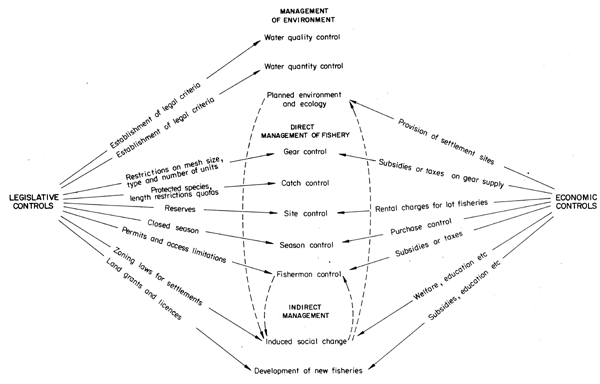
Fig 15 Diagram of relationships between the main techniques for fishery management
Because the numerous pressures arising from the various uses of land and water within river basins are exerting widespread effects detrimental to riverine fish communities and the fisheries that depend on them, it is clear that careful management is needed if the fisheries are to be maintained. Management should take place at two levels: (i) the river basin as a whole, and (ii) the fishery. This sub-chapter will discuss the first aspect, and the second will be treated in a separate sub-chapter to follow.
The major concerns at basin level are to ensure that the overall pattern of land and water use are such that the quantity and quality of water in the river systems are adequate for the maintenance of a healthy fish community.
Control of erosion and run-off: At the most general level, preservation of water quality and quantity involves a measure of control on agricultural and forestry practices within the basin area to ensure that erosion and siltation do not become excessive. At the same time, sufficient vegetation cover should be retained for the diffusion of surface flow to avoid flash flooding.
Maintenance of natural river habitat: The conservation of the fish community requires that, within the overall planning of a river basin, sufficient area be set aside to serve as reserves where the habitat appropriate to the various stages in the life history of the species inhabiting the basin can be safeguarded. This applies particularly to such specialized habitat types as gravel spawning beds in the rhithron zone of lower order rivers or the floodplain zones of the potamon in higher order streams.
Maintenance of adequate flow: Maintenance of adequate flow regimes is a necessity in partially regulated systems, as witnessed by the poor state of fisheries where normal flow regimes have been suppressed either by man-made dams or by natural shifts in climate. In fully regulated systems where reserves are set aside, their creation should be accompanied by measures to ensure that flow regimes are adequate for the maintenance of the fish stock. Legislation has been sought in much of the temperate zone to ensure at least minimum flows for sport fisheries, but so far no advance has been made for flood simulation for the preservation of food fisheries on floodplains. Such experiments as have been made, for instance on the Pongolo River in South Africa (Phelines et al., 1973) show that such controlled releases of water from dams can simulate a flood well enough for fish to breed and recruitment to occur. However, some of the primary objectives for which the dam was constructed may have to be sacrificed in that the volume of water retained for use during the dry season is lessened. However, with the results of more studies of this type being available in the future, it should be possible to incorporate flow requirements for fisheries into the early planning of dam design and operation.
Maintenance of water quality: During the past century the quality of river water throughout the temperate zones deteriorated rapidly as urbanization and industrial development placed increasingly heavy loads in the water. A similar process now appears to be taking place in some tropical and sub-tropical rivers where various agricultural formulations are also added to the original hazards. Most of the temperate countries have responded to the pollution of their waters by strict legislation for water quality control that is aimed more at public health than at fisheries. Such legislation has laid down norms for discharges from sewage-treatment plants as well as for industrial effluents and has had a measure of success in that some river reaches have been rehabilitated. This type of legislation is based on an extensive knowledge of the tolerances of human or aquatic life to the major contaminants appearing in waters. Unfortunately, such basic information is often lacking for tropical and sub-tropical waters where similar legislation is now urgently required.
Artificial structures for habitat improvement: In rivers where there are stocks of fish which are used for angling, the value of the resource is such as to justify artificial manipulation of the environment. Various types of gabions, flow deflectors, bank strengtheners and artificial cover have been experimented with over the past century. Many of these have been accepted as standard for the improvement of conditions for specific species of fish such as trout or salmon.
More specialized are the variety of structures used to by-pass weirs, dams or other obstructions in the river. These are aimed at assuring passage for migrating fish and were originally derived for salmonids in north temperate rivers. Fish passes, particularly, have more recently been used in a number of tropical and sub-tropical systems in association with hydro-electric dams. Such experiments have met with indifferent success. In most cases, the pass, whose design was based on experience with salmonids, has proved ill adapted to the behaviour patterns of other types of fish. Even when fish have accepted the ladder as a migratory pathway, the numbers of fish seeking to use it have proved excessive. There is no doubt that with the continuing increase in the number of dams in major rivers there is a need for further research into by-pass structures adapted to migratory species in general.
Provision of facilities for the fishery: In some areas adequate fish stocks are present but do not support a fishery for a variety of reasons. Among these is inaccessibility, and the failure to provide adequate road, rail or river transport links between fishing areas and their markets. As an essential step in development, such communications should be included in overall planning within a river basin area and usually benefit sectors other than fisheries as well. Similarly, many fisheries, particularly those of large floodplains, are limited by the lack of suitable places for the fishermen to camp. This has been overcome in some areas by occupation of levees and emergent islands but on some plains even these are not available. In such areas, fishermen have responded by the building of stilt houses where adequate timber is available and by the construction of artificial earthen mounds where building material is lacking. These latter usually measure some ares in area, emerge above the maximum flood level, and are readily constructed with the aid of earth-moving machinery.
A further factor limiting the effectiveness of a fishery to provide good quality fish is the lack of wood for smoking. Although alternatives exist, smoke-drying is still one of the cheapest and easiest ways to preserve fish. In areas where the technique is common, local reafforestation could provide for quick growing woods which are suitable for this purpose.
Overall planning: From the foregoing, it is evident that fisheries can only be developed and managed in a river in close collaboration with all other users of the basin. For this reason, those authorities responsible for inland fisheries in a country should have mechanisms whereby they can participate in the planning of the integrated development of areas under their jurisdiction. Unfortunately, until recently little information on these types of waters and their fisheries has been available to decision-makers. For this reason, the fisheries sector has tended to be neglected when river basin development plans have been drawn up. With the increasing availability of information it is now for high level decision-makers to weigh the balance between the various interested parties to ensure that, with proper planning and some degree of compromise, fisheries be sustained alongside other uses to provide good quality protein-rich food.
One of the most widespread approaches to management involves some control of fishing gear. This takes two main forms - the banning of certain types of fishing methods and the restriction of mesh sizes in mesh-selective gears.
Banning of certain gears: The restriction or outlawing of certain types of destructive gear is particularly important. The most obvious example of this is in the case of poisons and explosives, whose use is particularly common throughout Africa and Latin America or electric fishing and trained birds as used in parts of Asia. These methods are particularly damaging when applied to residual pools in river channels or in permanent standing waters of the flood plain as it is in these that the fish stock is conserved during the dry season. However, in temporary pools on the floodplain or in river channels the use of fish toxicants is quite valuable as it permits the nearly total exploitation of fish which would in any case disappear as the water body desiccated. Other devices which are not generally favourable are barrage traps, which seal off sections of the river or of channels communicating with the floodplain, interfering with the movements of the fish and at their most extreme prevent fish from reaching their spawning sites.
Mesh regulation: Much of the theory underlying mesh restriction is based on a standard population dynamics theory and is aimed at a particular species or group of species with similar size or growth characteristics. As such, the control of mesh size in mesh-selective gear is an excellent device where the fishery is based on a certain number of species of high economic importance. In multi-species stocks, however, this solution is not overly satisfactory as many species and often the majority of the available biomass is thereby rendered inaccessible to the fishery. Furthermore, the restrictions on mesh size should be accompanied by a strict policing and, where possible, with restrictions in the numbers of fishermen and gear in use. If not, the mesh size will tend to drift downward as a particular size class of fish becomes exhausted.
Catch control measures are rarely used in commercial river fisheries although in sports fisheries restrictions on the number and size of fish that can be taken are often applied. Such quota systems are difficult to enforce in rivers because of the large numbers of fishermen. The spatial restriction on length of certain species or the protection of rare or valuable fish have also been tried. Such attempts have usually failed because of the difficulties in policing such regulations.
The setting aside of reserved areas or the protection of habitats such as spawning grounds crucial to the survival of certain species are clearly desirable. In fact, many of the traditional methods of fishery regulations involve such provisions, but these tend to break down as pressure on the resource increases. One specialized type of site control is the practice of dividing rivers and their floodplain depression lakes into “lots”, which are then auctioned off to individual fishermen or to groups who have sole fishing rights in their particular lot. If the duration of the rental period is too short or the rental charge too high, the fishermen are forced to fish destructively to recuperate their investment. By contrast, in those areas where local land tenure assigns areas of river or floodplain to individuals and their families over many years, there is sufficient incentive for them to improve the area under their charge and to manage it systematically.
As with site controls, there are usually considerable regulations governing seasons of fishing in traditional fishing communities. These tend to persist for longer than season controls if only because they are largely dictated by the physical condition of the river or the behaviour of the fish. Thus, during flooding on floodplains the fish are so dispersed as to be inaccessible to most methods of fishing and for this reason, throughout the world, there is little fishing at such times. It is, however, frequently necessary to introduce new regulations based on an improved understanding of the biology of a particular species, to prevent fishing during the spawning season, or when fish are congregated in the much reduced water area during the dry season when prespawning fish are especially vulnerable to certain fishing methods.
River fisheries, in common with most others, react to an increase in the number of fishermen exploiting them by a reduction in catch per fisherman and, after a certain optimum number of fishermen per unit area is reached, by a reduction in total catch. Such fisheries are, therefore, sensitive to increases in effort which may be produced either by increasing the number of fishermen at the same level of technical efficiency or by increasing the efficiency of the individual fisherman. In this latter case, where a fishery is already nearing full exploitation, advances in individual catching power made through technological innovations can only be made by a compensatory reduction in the number of fishermen.
Control of fishermen number is perhaps one of the simplest theoretical ways of controlling an artisanal fishery, although the practical aspects of such control, licensing, taxes or policing, etc., raise considerable difficulties. As far as we know from existing data, the optimum number of fishermen on river floodplains is about 10/km² as above this figure catches start to decline and fish stocks show other signs of over-exploitation. In fact, it is difficult to use fishermen as a simple measure of effort because the majority of the occupants of flood plains are fishermen/farmers. Fishermen of this type tend to modify the proportion of time they devote to the respective activities relative to the benefits they obtain. Thus, where there is an intense pressure on the fishery individuals will spend less time fishing than farming. This gives the fishery considerable flexibility and tends to avoid gross over-exploitation although some cases of this are known.
Controlling effort in the fishery may be achieved by methods other than licensing, for instance by induced social changes, whereby a certain proportion of the fishing effort is removed either by upgrading the fishermen's alternative activity or by providing employment elsewhere. The converse of this applies in underdeveloped fisheries where individuals can be induced to enter the fishery through training in fishing methods, subsidies and provision of suitable infrastructures such as roads, schools, living sites, etc.
Under the “Management of river systems for fisheries” several methods for the conservation or improvement of the environment are described. Further methods involve the improvement of fish stocks either by the elimination of unwanted elements or by the introduction of new species. For example, one of the greatest problems in Latin America for the development of certain types of river and reservoir fisheries is the proliferation of piranas. In other regions of the world the over-expansion of various types of trash fish which compete with more favoured commercial species also limit the effectiveness of the fishery. This problem has not yet been solved, although in high value sports fisheries wholesale poisoning of an environment to remove all fish prior to restocking with the selected species is practised. Similarly, in the small dams of northeast Brazil attempts have been made at eradication of piranas with poisons (Braga Adhemar, 1976).
Stocking programmes are also employed in such waters so as to artificially maintain a species abundance ratio weighted in favour of the selected species. This, again, has proved very popular in salmonid fisheries in the temperate zones but is also used in small dams and reservoirs in the tropics.
At first sight the introduction of new components into a fish community that is already highly complex may appear unnecessary. However, such are the changes that take place in a modified riverine ecosystem that very often species competent to colonize the waters under the new regime are lacking. When this occurs, introduction of a new element to the fauna to fill the recent niche may be proposed. Any such proposed introductions should be examined most carefully before they are carried out as there is a considerable risk that the exotic species may turn out to be a pest, or to compete with existing species. Equally, disease organisms may be introduced along with the fish. Nevertheless, certain introductions can be considered successful in certain areas.
As indicated in Table 3, as a river basin is increasingly developed for agriculture, industry and human settlement, the original fishery which has formed the main topic of this manual, shrinks and in extreme cases eventually disappears. It is replaced by two new types of fishery: (i) reservoir fisheries in the new lakes formed behind power and irrigation and flood-control dams; and (ii) aquaculture.
The most common gross modification to a river is the creation of dams. Initially, these may be relatively small impoundments on tributaries but culminate in large main-stem reservoirs. It has been a feature of all such dams that they have been developed for fisheries which, in some cases, have eventually come to form a considerable proportion of the social and economic benefits created by the structure. The development and management of reservoirs has formed the subject of considerable independent study and is discussed at length in publications other than this one. Nevertheless, from the point of view of river basin management there are certain principles which are of interest. The first of these is an assessment of the yield to be expected from a new or proposed reservoir. This is needed both to assess the impacts of the modification of the system on fish production within the basin and to plan for the infrastructure needed for the new fishery.
The simplest measure for the assessment of fish products in new reservoirs is possibly the morpho-edaphic index (MEI). This index:

is based on the simple parameters of conductivity and mean depth of reservoir both of which can be obtained prior to the construction of the barrage. In Africa, the index was converted to actual yields by Henderson and Welcomme (1974) applying the relationship:
| Y = 14.3136 MEI0.4681 | |
| where | Y = yield in kg/ha |
Comparison of the African data with other tropical continental areas has shown that reservoir yields in S.E. Asia and Latin America tend to be somewhat lower. This is thought to be because there are insufficient lacustrine species in these two continental areas to adequately colonize the new water body. Where species such as Tilapia have been introduced to compensate for this, yields have approached or even surpassed those of Africa.
In contrast to rivers, reservoirs and lakes support far fewer fishermen and in Africa the available information indicates that optimum yields are attained with fishermen densities equivalent to 1–2 fishermen/km². These much lower figures are probably because most fishermen on lakes work in the fishery full time. It cannot be hoped, therefore, that a new reservoir can absorb more than a small part of the fishermen from the original river.
The natural production of rivers can be exceeded by various forms of husbandry or intensive aquaculture. These are widespread on floodplains in their original state and various techniques are available for the different developmental stages of rivers.
Blocking of natural floodplain depressions: Complete blocking of small channels leading water out of depressions with temporary dams of earth and vegetation is common in many systems. The pool thus created is fished, often much later in the dry season. This method constitutes the first systematic attempt at husbandry or extensive aquaculture. Experiments with simple but more permanent dams made of wooden posts, earth and clay-filled sacks have been carried out by Reed (FAO/UN, 1969) in the Niger River and Reizer (1974) in the Senegal. The area of the pools retained in such areas are much increased (Fig. 16), and Fig. 17 shows how the level and area of such pools differ before and after damming. Harvests from such pools are quite respectable - about 185 kg/ha/year in the otherwise unmanaged state, but management by stocking with fry and feeding with agricultural wastes such as rice husks can improve production up to 500 kg/ha/year.
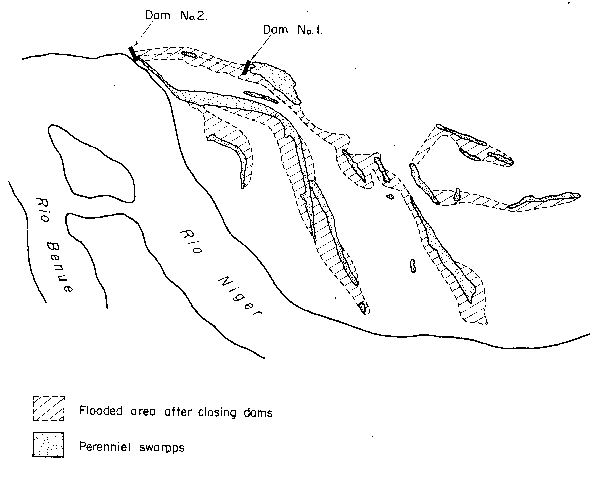
Fig. 16 Area of floodplain depression lakes before and after installation of dams blocking drainage channels

Fig. 17 Differences in maximum depth (A) and area (B) in a floodplain lagoon before and after damming
Drain-in ponds: In more advanced culture systems on floodplains the depressions are regularized and deepened and eventually drain-in ponds may be dug into the surface of the plain. At present three river systems have benefited from this form of management. In the Oueme River basin (Africa) about 3% of the 1 000 km² surface area of the plain is occupied by drain-in ponds, some of which are kilometres long but which are otherwise constructed as in Fig. 18. Similar constructions on the Mekong floodplain ranged between 20 and 100 m in length and 2–3 m in depth. In Bangladesh some 30 000 ponds are formed from the borrow-pits which are excavated during the construction of artificial islands. Drain-in ponds usually become heavily overgrown with aquatic vegetation during the dry season. They also become deoxygenated, often anoxic and have relatively very high water temperatures. Thus, although they are originally colonized by a variety of species during the earlier part of the draw-down, only the most hardy fish survive. These are usually air breathers such as Clarias, Channa, Ophicephalus, Anabas or Protopterus. The ponds are usually fished by blocking a portion with a bamboo barrier, removing the vegetation contained in the isolated portion and advancing the barrier until the fish are enclosed in a small space from which they may easily be removed with hand nets and baskets.
Yields from drain-in ponds may be high. In the Oueme the ponds produced a mean of 2.1 t/ha/year in 1955-58 and ten years later were still producing 1.5 t/ha/year despite intensive overfishing throughout the rest of the system.
Drain-in ponds are also widely used in conjunction with aquaculture. In Africa crops such as peppers or tomatoes are grown on the raised banks and floodplain crops such as maize may be grown in the intervening spaces. In Asia the ponds are usually associated with rice-fields as a retreat for fish as the water is drained prior to harvesting.
Refuge traps and brush parks: In the Oueme River vegetation masses may be planted deliberately at the end of the flood, either attached to the bank or recessed into it at the mouth of the channels which drain the plain (Fig. 18). They are left to collect fish for about two months, after which they are fished and replaced to be emptied again toward the end of the dry season. harvests from such refuge traps or fish parks can be quite high and in the Oueme River harvests equivalent to 1.88 t/ha (of park) per fishing or 3.88 t/ha/year are obtained.
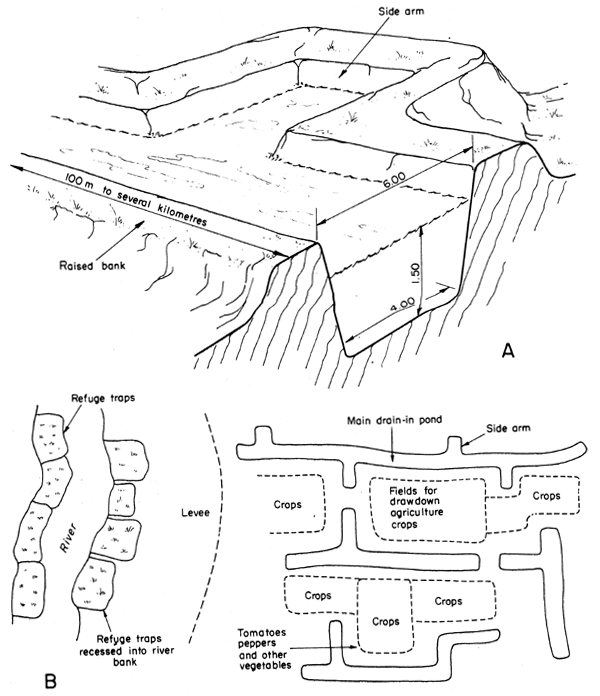
Fig. 18 A. Construction of a typical drain-in pond on the Ouémé delta
B. Situation of ponds on plain
The practice of deliberately planting vegetation or branches on the water to attract fish is, in fact, very widespread, having been recorded from the Mekong in S.E. Asia, the Gangetic system in Bangladesh, the Niger and Benue systems in Africa and in Ecuador. The techniques of refuge traps fishing in the Oueme and its associated lagoons has been described in detail by Welcomme (1972). The refuge traps in the Oueme River and its associated lakes and lagoons are of two main types in addition to the masses of floating vegetation described above. There are small simple circular types about 22 m² in area (Fig. 19) which give up to 2.8 t/ha for each harvest. As they are harvested up to ten times during the seven-month dry season an annual yield as high as 28 t/ha can be obtained without apparently affecting the catch by other fishing methods in the area. Larger rectangular parks or “acadjas” are much more complex in their construction (Fig. 20) and are harvested less frequently, but also achieve very high yields. In the freshwater zone, a variety of species are attracted to the Oueme fish parks from which up to 32 species were recorded. By contrast, in the brackishwater zone, only two species, Sarotherodon melanotheron and Chrysichthys nigrodigitatus made up 95% of the individuals present. These breed actively in the fish park throughout the year and as a consequence the population builds up rapidly (Fig. 21) thus accounting for the very high yields of up to 8 t/ha/year in 1957–59.
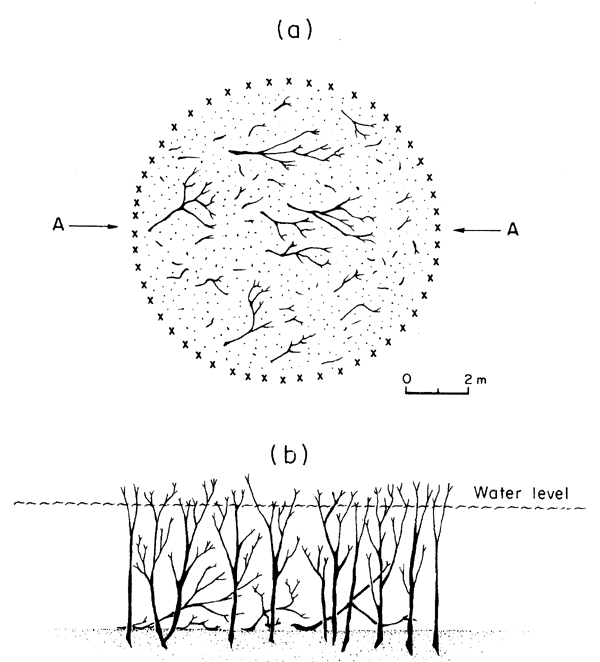
Fig. 19 Small circular pattern of refuge trap as used in the Ouémé delta
upright hardwood branches
softwood branches laid flat on bottom
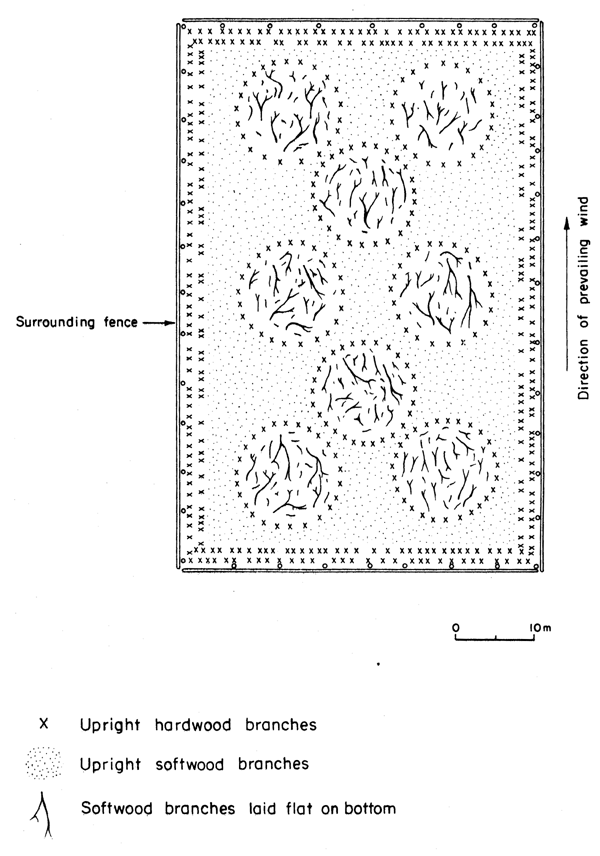
Fig. 20 Plan of construction of rectangular refuge trap as used in the Ouémé delta: note complexity
upright individual branches
upright softwood branches
softwood branches laid flat on bottom
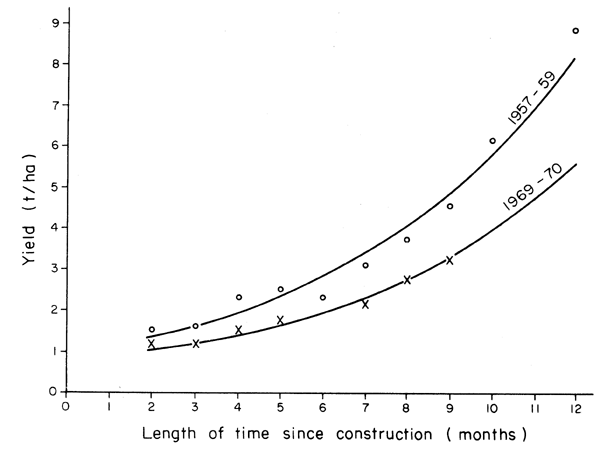
Fig. 21 Relationship between yield and length of time of installation for two series of brush parks installed in the Nokoué lagoon of the Ouémé River delta
The yield of brush parks appears to be directly related to the density of planting; the greater the number of branches per unit area the greater the catch. In Lake Aheme, another Benin lagoon, yields rose from about 20 kg/ha at a planting density of 1 branch/m² to 20 t/ha at a planting density of 20 branches/m².
More recent investigations have shown that the fish stock increased in a similar manner in 1969-70 although yields were somewhat lower as a result of changes in the lagoon environment brought about by the construction of a port. The only other such installations that have been systematically investigated are the “Samra” parks of the Grand Lac of the Mekong system which appear to have given comparable yields to the Benin type of installation. Brush park fisheries are regarded by many as a somewhat mixed blessing. There is little doubt that they put up the overall productivity of the body of water in which they are used, but they also may shorten its life through accelerated silting. They also rely on a considerable supply of wood, up to 60 tons/ha, which requires special plantations if the adjacent natural forests are not be depleted.
The widespread practice of fish culture in rice fields may be considered an almost ideal method of land use which produces both a carbohydrate and protein crop from the same piece of land. It has reached very high standards in Asia and Madagascar but is still in the experimental stage in Africa and Latin America. Coche (1967) has dealt comprehensively with the situation up to fifteen years ago. Two main types of exploitation can be distinguished:
(i) capture systems where the fish that gain access through natural channels may be trapped:
(ii) culture systems where the field is deliberately stocked with fry.
The fish may be taken as a single annual crop with a single rice crop, an intermediate crop between one rice harvest and the next planting during the growing season of the rice or as an alternative crop where rotation is practised. Frequently fish are trapped casually during the growing season, and are then drained into specially constructed sump ponds or canals as the fields are dried. Yields from trapping during the growing period have been measured at about 132 kg/ha by Tang Cheng Eng et al. (1973). If the rice is cropped only once a year, the sump ponds yield about 162.8 to 262.9 kg/ha (mean 200 kg/ha) but if the field is double cropped fish yields drop to 68.2–143.0 (mean 95.7) kg/ha. At the same time between 2 277 and 2 975 kg/ha of rice were produced. Fish represents between 12–50% of the total income in single cropping and 6–27% in double cropping system. Similar yields have been recorded in Thailand in the Mekong basin where 433 km² of paddy fields were sampled giving fish harvests ranging between 50 and 1 710 kg/ha² (mean 433 kg/ha²) (Thailand, Department of Fisheries, 1974).
As described in the chapter on competing uses, there has been a long-term decline in yield from ricefield fish production. The main reasons for this are: the increasing using of pesticides, weedicides and fungicides associated with the modern advanced agrarian practices needed to grow the high-yielding varieties of paddy.
Furthermore, the concept of multiple cropping in rice cultivation leaves little scope for fish culture because of the short duration of the flood over the rice field.
The production of a plant and a protein crop from the same area of floodable land is undoubtedly of great value in maintaining a nutritionally balanced yield pattern, although one that is not necessarily maximal in terms of absolute tonnage. Consequently, projects have been suggested for the extension of this type of culture. For instance, the management of the 32 000 ha Candaba Swamp, which is flooded by the Pampanga and Angat rivers and is one of a similar series of floodplains in the Philippines. The plain has been enclosed in a series of dikes which include a canal for the harvesting of fish (Fig. 22). The fields are at present used for water melon or rice growing during the dry season when the fish remain in the canals. Fish yields based solely on natural productivity range from 300 to 500 kg/ha² in seven months. The melon crop produces 5 000 kg/ha². Delmendo (1969) suggested ways in which this area could be improved with the inclusion of fish canals at the foot of the main dikes and an intensification of fish culture by stocking and manuring the ponds.
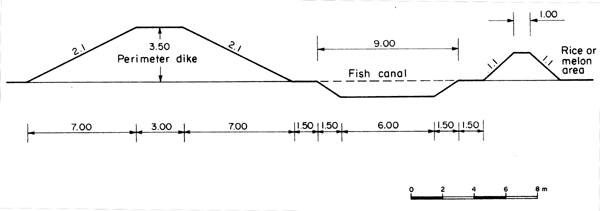
Fig. 22 Diagramatic cross-section of a pond layout for rice or water melon rotation in the Candaba floodplain, Philippines (after Delmendo, 1969) (measurements are in metres)
The many techniques for aquaculture in ponds and small dams in both temperate and tropical river valleys are described in numerous manuals and textbooks. Normally, the flood plains of the potamon are not suitable for this type of development due to the occasional invasion of the ponds by flood waters. However, once the flow is completely controlled and the former flood plain is dried and converted to agriculture, aquaculture farms of the traditional pattern may be developed. This is especially easy where there are irrigation networks to which ponds can be associated. The impervious nature of the alluvial soils, the flat terrain and the ready access to plentiful water supplies through canals make this type of modified floodplain particularly suitable for intensive pond culture. Such farms can either rear fish to a size suitable for direct consumption or they can raise fry for stocking into such permanent lakes as remain on the plain into nearby reservoirs or into fields where fish are reared as a secondary or alternative crop.
Once flow is stabilized within the main river channels or even before such stabilization occurs, fish may be cultured in floating cages. This type of culture usually applies to species of high commercial value, such as Pangasius sutchii which is cultured in this manner in Thailand. The fish are usually caught as fry and reared to marketable size in such structures.